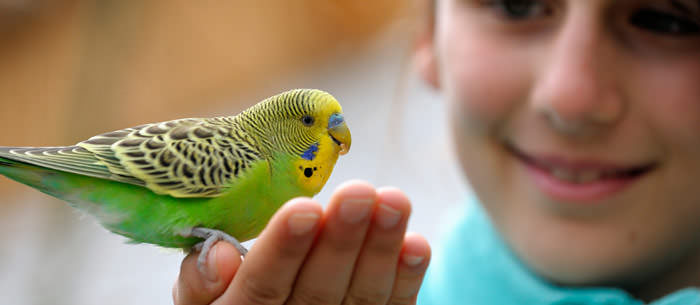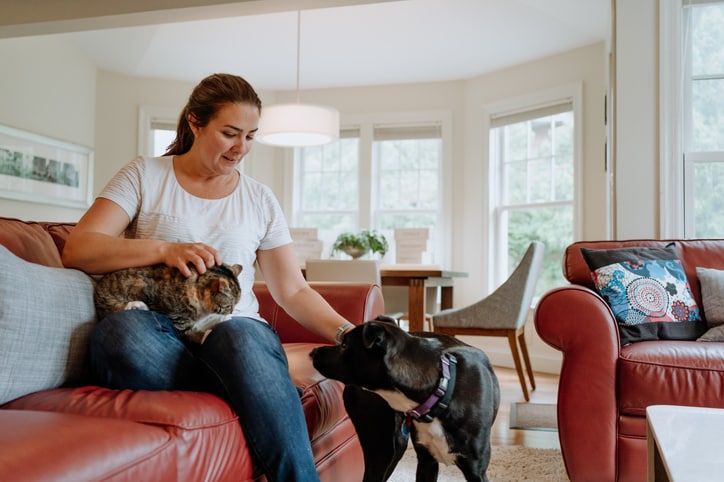Thinking about getting a pet bird? Here’s an overview of things to consider before making that commitment.
I walked into my vet’s office and heard a cheery “Hello!” I rounded the corner and found the reception area empty, except for the doctor’s pet birds. As nice as it sounds to have a pet that can welcome you when you walk in the door, choosing the right bird goes far beyond “Polly wants a cracker.”
Types of Birds
From talking parrots to tiny yellow canaries, birds are fascinating creatures. But the needs of different birds are as varied as the colors of their feathers. According to the Humane Society of the United States, the following birds have a long history of selective breeding in captivity and are considered domesticated strains of wild species:
- canaries
- finches
- cockatiels
- parakeets
- lovebirds
These birds are relatively easy to care for and are recommended for families looking for their first bird. In general, smaller birds are easier to take care of than larger birds. But beware, even little birds can make a big mess! Cleaning the birdcage will become a regular part of your life once you have a bird.
On the other hand, the following species have not undergone the same process of long captive breeding and genetic selection. The Humane Society considers them to be wild birds, even when they’re bred in captivity:
- conures
- parrots
- macaws
- cockatoos
- toucans.
Because of their natural, wild traits, these birds are much more demanding pets and require their owners to make a serious commitment to care for them.
Lifestyle and Lifespan
There’s a lot to consider when choosing a pet bird. To help you make a well-informed decision, talk to a bird expert, such as a reputable breeder or a vet who specializes in avian companions. Here are a few general things to keep in mind when looking for a pet bird.
First of all, consider how much time you can devote to your feathered friend. Some birds, like finches and canaries, generally don’t like to be handled by humans. They prefer to live in small flocks, so consider getting more than one bird at a time. (And be sure to get a cage that is large enough to allow them to fly around inside. Ask for a “flight cage” at the pet store.) These beautiful little birds are known for their lovely songs, making them a good option if you want a pet to look at but not touch.
But if you or your kids prefer a bird that tolerates being handled, consider a parakeet or cockatiel instead. Keep in mind that even these relatively mild-mannered birds can bite or peck, so talk to a knowledgeable bird expert to learn how to correctly handle and care for a pet bird.
Other birds, like parrots, need daily exercise and extended periods of human interaction outside of a cage. Some birds can form very close bonds with their owners. If that relationship is neglected, a pet bird can become depressed and unwell. Before getting any bird, find out what living conditions are best for a particular species so you can provide the right environment to keep your bird happy and healthy.
Also think about a bird’s life expectancy. Parakeets live an average of 12 to 14 years, but an African Grey Parrot can live 50 to 70 years! When taking in a bird with a long lifespan, plan ahead for the bird’s continued care in case it outlives you.
Money
Your budget is another important factor to consider when choosing a bird. For starters, large birds can cost thousands of dollars to purchase. Cages and other supplies can also be costly, even for smaller birds. As of March 2008, The American Society for the Prevention of Cruelty to Animals (ASPCA) estimates that a small bird will cost its owner $270 in “set-up” costs and $200 in regular annual costs. Find out what you need to buy to properly care for your bird before making the commitment to bring one home.
Food
Birds have specialized dietary needs. A handful of seeds just won’t cut it for every bird. Before choosing a bird, find out what kind of food it eats. Does it need fresh fruit and veggies? A special kind of seed? Nectar and pollen? Make sure you’re up to the task of properly feeding that winged companion.
A Word of Caution
Although birds can spread germs to people, the U.S. Center for Disease Control (CDC) maintains that illness caused by touching or owning birds is rare. However, people with compromised immune systems, including children under the age of 5, are at greater risk of getting diseases from animals. Visit the CDC website to learn more about the germs that birds can pass on to humans and how to protect yourself.
Adopt, Adopt, Adopt!
Instead of buying a bird, find out if any birds are available for adoption in your area. Call your local animal shelter, or visit Pets911 and PetFinder to find adoptable birds near you.
Why is adopting better than buying? Many birds available for commercial sale come from bird mills, which churn out thousands of birds in terrible living conditions. These mills often sell their birds to pet stores. Buying such a bird perpetuates this cruel industry. Of course, it’s possible that an adoptable bird is also the product of a bird mill. But adopting a bird abandoned by its previous owner does not contribute to the mill trade in the way that purchasing one does.
Also, be aware of the legal restrictions on the importation of birds from other countries. Despite the laws, too many birds for sale have been trapped in the wild, which is cruel to the animals and threatens the survival of many different species.
As with any pet, birds require commitment, care, and love. If you choose wisely, your new bird can be a source of delight, companionship, and feathered fun.
Jennifer McGuiggan is a freelance writer. She lives in Pennsylvania with her husband and two grey cats.


